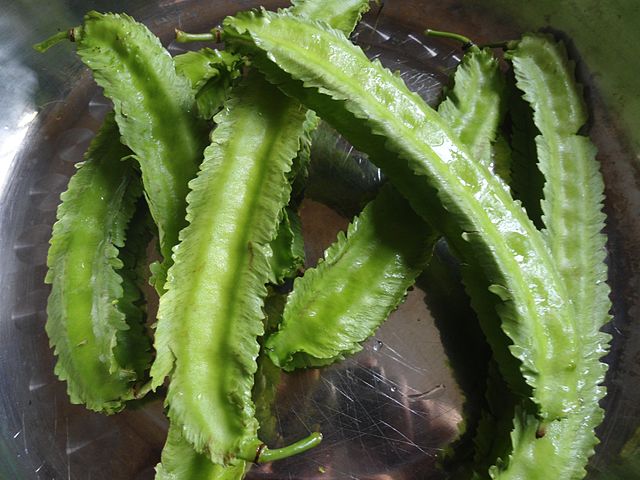Description
Winged beans (Psophocarpus tetragonolobus) are tropical legumes known for their unique four-angled seed pods. These climbing plants, which can reach up to 4 meters in height, thrive in warm, humid climates. Popular in home gardens, winged beans are valued for their versatility, as nearly all parts of the plant are edible. The pods are angular with frilled edges and can be smooth or waxy in texture. They contain a few round to oval seeds that can be ivory, green, or brown. There are two main types of winged bean; short podded ones which are used for tubers and have poor seeds, and long podded ones which have good seeds but poor tubers.
SLS 44
- Produces yield throughout the year
- White flowers
- Green pods, weighing around 15g each
- Cream-colored seeds
Krishna
- High yield throughout the year
- Purple flowers and pods
- Dark purple seeds
- Pods about 27 cm long
Planting requirements
Planting season: Best planted in March to April and November to December
Planting conditions:
| Propagation | Seeds that are planted during rainy season germinate and grow slowly for the first 3 or 5 weeks. For tubers, vines are pruned off at about 1 m high or left unstaked and flowers are removed |
|---|---|
| Planting method | Plant seeds in rows that are 60 cm apart with a spacing of 25 cm between plants. Soak seeds in water for about 24 hours before planting for better germination |
| Soil | Grows on a wide variety of soils. Well-draining sandy loam or clay loam soil with organic matter is ideal. Soil should not retain too much water and should have a pH between 5.5 and 7 |
| Water | Requires regular watering but is intolerant of water logging |
| Light | Partial sunlight as shading improves pod length and seed number but excessive shade can reduce yield |
Growing conditions:
| Temperatures | For maximum seed production winged beans requires temperatures between 23°C and 27°C and for tubers the temperatures should be between 18°C and 25°C |
|---|---|
| Soil | Winged beans have been grown on soils with pH from 3.6 to 8.0. They are sensitive to very acidic soils and prefer well-drained soil with a high organic matter content. Provide trellises or poles (about 7 ft tall) for vine support |
| Water | Water them in the morning before the heat of the day absorbs the moisture. As they grow in warm and wet tropics, they need moisture with regular watering, about 1 inch per week |
| Pruning | Prune plants to encourage bushier growth and more pods |
| Weed control | Keep the area around winged bean plants weed-free to prevent competition for nutrients and water |
Harvesting
First harvest of recommended varieties can be taken in 70-75 days. For improved varieties, 90-100 days and for local varieties harvest pods every 3-4 days. Tubers can be harvested 4-5 months after planting.
Curing
After harvesting, cure pods at room temperature for a week before storing.
Storage
Store pods in the refrigerator for up to two weeks. Tubers can be stored in a cool, dry place for several months.
Protecting your plants
Pest control
Pest type:
- Aphids
- Nematodes
- Mites
Symptoms:
- Aphids: Stunted growth, yellowing of leaves, and sticky residue on leaves (honeydew).
- Nematodes: Wilting, stunted growth, and root galls.
- Mites: Leaf discoloration, stippling, and webbing on leaves.
Control method:
- Aphids: Use insecticidal soap or neem oil to manage infestations and encourage natural predators like ladybugs.
- Nematodes: Improve soil drainage and rotate crops to disrupt nematode life cycles. Soil solarization may also help reduce nematode populations.
- Mites: Introduce predatory mites or apply miticides as needed.
Disease Control
Disease type:
- Powdery Mildew
- Leaf Spot
- Bacterial Wilt (Ralstonia solanacearum)
Symptoms:
- Powdery Mildew: White powdery spots on leaves and stems, leading to leaf drop.
- Leaf Spot: Dark spots on leaves that can lead to premature leaf drop.
- Bacterial Wilt: Sudden wilting of plants even under optimal moisture conditions; oozing from cut stems.
Management:
- Powdery Mildew: Apply copper fungicides or sulfur sprays to prevent and manage outbreaks.
- Leaf Spot: Use copper-based fungicides or sulfur sprays to control the spread of spores.
- Bacterial Wilt: Remove infected plants and improve drainage; no chemical treatments are available for bacterial diseases.
Sources
In addition to our General List of Sources (link), we used these specific references:
- https://doa.gov.lk/hordi-crop-winged-bean/
- https://doa.gov.lk/hordi-variety3-winged-bean/
- https://www.epicgardening.com/winged-bean/
- https://www.thespruce.com/companion-plants-for-beans-2540036
- https://en.wikipedia.org/wiki/Winged_bean
- https://www.appropedia.org/The_Winged_Bean_High_Protein_Crop_for_the_Humid_Tropics_7
